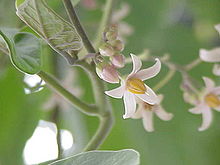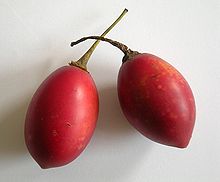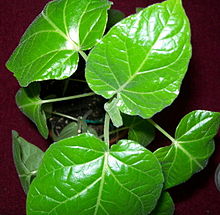- Tamarillo
-
This article is about the fruit. For other uses, see Tamarillo (disambiguation).
Tamarillo 
Conservation status Scientific classification Kingdom: Plantae (unranked): Angiosperms (unranked): Eudicots (unranked): Asterids Order: Solanales Family: Solanaceae Genus: Solanum Species: S. betaceum Binomial name Solanum betaceum
Cav.Solanum betaceum (syn. Cyphomandra betacea) is a small tree or shrub in the flowering plant family Solanaceae. It is best known as the species that bears the tamarillo, an egg-shaped edible fruit. Other names include tree tomato and tomate de árbol.
Contents
Description
Plant origin and regions of cultivation
The tamarillo is native to the Andes of Peru, Chile, Ecuador, Colombia and Bolivia. Today, it is still cultivated in gardens and small orchards for local production,[1] and it is one of the most popular fruits in these regions.[2] Other regions of cultivation are the subtropical areas throughout the world, such as South Africa, India, Hong Kong, China, United States, Australia, and New Zealand.[1]
The first internationally marketed crop of tamarillos in Australia was produced around 1996, although permaculture and exotic fruit enthusiasts had increasingly grown the fruit around the country from the mid nineteen seventies on.
In New Zealand, about 2000 tons are produced on 200 hectares of land and exported to the United States, Japan[3] and Europe. For the export, the existing marketing channels developed for the kiwifruit are used.[1]
The tamarillo is also successfully grown at higher elevations of Malaysia and the Philippines, and in Puerto Rico.[2] In the hot tropical lowlands, it develops only small fruits and fruit setting is seldom.
Prior to 1967, the tamarillo was known as the "tree tomato" in New Zealand, but a new name was chosen by the New Zealand Tree Tomato Promotions Council in order to distinguish it from the ordinary garden tomato and increase its exotic appeal.[4] The choice is variously explained by similarity to the word "tomato", the Spanish word "amarillo", meaning yellow,[5] and a variation on the Maori word "tama", for "leadership". It is called Tree Tomato in most of the world.[6]
Plant
The plant is a fast-growing tree that grows up to 5 meters. Peak production is reached after 4 years,[3] and the life expectancy is about 12 years.[1] The tree usually forms a single upright trunk with lateral branches. The flowers and fruits hang from the lateral branches. The leaves are large, simple and perennial, and have a strong pungent smell.[3] The flowers are pink-white, and form clusters of 10 to 50 flowers. They produce 1 to 6 fruits per cluster. Plants can set fruit without cross-pollination, but the flowers are fragrant and attract insects. Cross-pollination seems to improve fruit set.[3] The roots are shallow and not very pronounced, therefore the plant is not tolerant to drought stress, and can be damaged by strong winds. Tamarillos will hybridize with many other cyphomandra solanaceae, though the hybrid fruits will be sterile, and unpalatable in some instances.
Fruit
The fruits are egg shaped and about 4-10 centimeters long. Their color varies from yellow and orange to red and almost purple. Sometimes they have dark, longitudinal stripes. Red fruits are more acetous, yellow and orange fruits are sweeter. The flesh has a firm texture and contains more and larger seeds than a common tomato.[1] The fruits are very high in vitamin and iron and low in calories (only about 40 calories per fruit).[3]
Fruit composition, some important components[1] Component [g/100g] Range Component [mg/100g] Range Water content 81-87 Vitamin A 0.32-1.48 Proteins 1.5-2.5 Vitamin C 19.7-57.8 Fat 0.05-1.28 Calcium 3.9-11.3 Fiber 1.4-6.0 Magnesium 19.7-22.3 Total acidity 1.0-2.4 Iron 0.4-0.94 Cultivation
Soil and climate requirements
The tamarillo prefers subtropical climate, with rainfall between 600 and 4000 millimeters and annual temperatures between 15 and 20 °C.[1] It is intolerant to frost (below -2 °C) and drought stress. It is assumed that fruit set is affected by night temperatures. Areas where citrus are cultivated provide good conditions for tamarillos as well, such as in the Mediterranean climate. Tamarillo plants grow best in light, deep, fertile soils, although they are not very demanding. However, soils must be permeable since the plants are not tolerant to water-logging.[1] They grow naturally on soils with a pH of 5 to 8.5.
Growth
Propagation is possible by both using seeds or cuttings.[1][7] Seedlings first develop a straight, about 1.5 to 1.8 meters tall trunk, before they branch out. Propagation by seeds is easy and ideal in protected environments. However, in orchards with different cultivars, cross-pollination will occur and characteristics of the cultivars get mixed up. Seedlings should be kept in the nursery until they reach a height of 1 to 1.5 meters, as they are very frost-sensitive.
Plants grown from cuttings branch out earlier and result in more shrub-like plants that are more suitable for exposed sites. Cuttings should be made from basal and aerial shoots, and should be free of pathogenic viruses. Plants grown from cuttings should be kept in the nursery until they reach a height of 0.5 to 1 meter.
The tree grows very quickly and is able to carry fruits after 1.5 to 2 years.[2] The plant is daylength-insensitive. The fruits do not mature simultaneously, unless the tree has been pruned. A single tree can produce more than 20 kg fruits per year, an orchard yields in 15 to 17 tons per hectare.[3] One single mature tree in good soil will bear more fruit than a normal family can eat in about 3 months.
Tamarillos are suitable for growing as indoor container plants, though their swift growth, their light, water and humidity requirements and their large leaves can pose a challenge to those with limited space.
Plant management
The tamarillo trees are adaptable and very easy to grow. However, some plant management strategies can help to stabilize and improve plant performance.
Planting
Planting distances depend on the growing system. In New Zealand, with mechanized production, single row planting distances of 1 to 1.5 meters between plants and 4.5 to 5 meters between rows are recommended. In traditional growing regions such as the Andean region, plantations are much more dense, with 1.2 to 1.5 meters between plants. Dense planting can be a strategy to protect plants against wind.[1] On poorly drained soils, plants should be planted on ridges.
Pruning
Pruning can help to control fruit size, plant size, harvest date and to simplify the harvest of fruits.[1] Cutting the tip of young plants leads to the desired branch height. Once the tree shape has been formed, pruning is reduced to the removal of old or dead wood and previously fruited branches, since branches that have already carried fruits will produce smaller fruits with lower quality the next time. Light pruning leads to medium sized, heavy pruning to large sized fruits. Basal shoots should be removed. When plants are grown in greenhouses, pruning prevents excessive vegetative growth.
When the tree is about 1 to 1.5 metres in height, it is advisable to cut the roots on one side and lean the tree to the other (in the direction of the midday sun at about 30 to 45 degrees). This allows fruiting branches to grow all along the trunk rather than just at the top.
Mulching
Since the plants are sensitive to drought stress, mulching can help to preserve moisture in the soil.[3] It can also be a strategy to suppress weeds, as other soil management techniques such as plowing is not possible due to the shallow and sensitive root system.
Shelter
The plants have to be protected from wind. Their shallow root system does not provide enough stability, and the lateral branches are fragile and break easily when carrying fruits.[1]
Irrigation and fertilisation
To maximize and stabilize production, water and nutrient inputs should be provided when needed. The plants need continuous supply of water due to their shallow root system. Drought stress results in a decrease of plant growth, fruit size and productivity.[1] Recommended fertilizer rates per hectare are 170 kg of Nitrogen, 45 kg of Phosphorus and 130 to 190 kg of Potassium for intensive New Zealand production systems. Phosphorus and Potassium are applied in the beginning of the season, Nitrogen applications are distributed throughout the year.[1]
Pest management
The tamarillo tree is, compared to similar crops such as tomatoes, quite resistant to pests in general. Still, to reduce risk in intensive production systems, some pests have to be controlled to avoid major crop damage. To control pests, the same control methods as for other solanaceae can be used.
pests Further Information Examples Viruses - Most significant diseases at many production sites
- Reduce tree's vigour and yield
- Leave scabs on fruits and therefore lower fruit quality
Tamarillo mosaic virus (TaMV) Nematodes - Only few nematodes have been found
- Serious damage on young trees
- Can be vectors of viruses
Meloidogyne incognita, M. javanica and M. hapla Insects - Can be vectors of viruses
- Feed on the fruits and other parts of the plant
Aphids, Greenhouse whitefly, Tomato worm Fungi - Leaf loss (defoliation)
Powdery mildew Harvest
Ripening of fruits is not simultaneous. Several harvests are necessary. In climates with little annual variation, tamarillo trees can flower and set fruit throughout the year. In climates with pronounced seasons (such as New Zealand), fruits ripen in fall. Premature harvest and ethylene induced ripening in controlled-atmosphere chambers is possible with minimal loss of fruit quality.[8] The fragile lateral branches can break easily when loaded with fruits, so premature harvest helps to reduce this risk and allows storage of fruits up to 20 days at room temperature. A cold water dipping process, developed by the New Zealand Department of Scientific and Industrial Research also allows further storage of 6–10 weeks.[1]
Usage
Culinary use
The fruit is eaten by scooping the flesh from a halved fruit. When lightly sugared and cooled, the flesh is used for a breakfast dish. Yellow-fruited cultivars have a sweeter flavor, occasionally compared to mango or apricot. The red-fruited variety, which is much more widely cultivated is more tart, and the savory aftertaste is far more pronounced. In the Northern Hemisphere, tamarillos are most frequently available from July until November, and fruits early in the season tend to be sweeter and less astringent.
They can be made into compotes, or added to stews (e.g. Boeuf Bourguignon), hollandaise, chutneys and curries. Desserts using this fruit include bavarois and, combined with apples, a strudel.
In Colombia, Ecuador and parts of Indonesia (including Sumatra and Sulawesi), fresh tamarillos are frequently blended together with water and sugar to make a juice. It is also available as a commercially pasteurized purée. In Nepal it is grown in the hill parts/mountains. it is yellow in colour and used as Pickle or chutney and used as Tomato for Curry .it is known in Nepal As ram bheda,rukh( tree) bheda, or tree tomato.
The flesh of the tamarillo is tangy and variably sweet, with a bold and complex flavor, and may be compared to kiwifruit, tomato, guava, or passion fruit. The skin and the flesh near it have a bitter taste and are not usually eaten raw.[9]
The tamarillo has been described as having a taste similar to that of a passion fruit and a piquant tomato combined.[citation needed]
The red and purple types of fruits are preferred in import countries of Europe: Even though they taste more acidic, their color is favoured by consumers.[1]
Industrial use
The fruits are high in pectin and therefore have good properties for preserves. However, they oxidize and lose color when not treated. Yellow fruit types are better applicable for industrial use.
Prospects
Research and breeding should improve plantation management, fruit quality and postharvest treatment.[3] A better understanding of plant physiology, nutritional requirements of plants and fruit set mechanisms will help to improve growing systems. Breeding goals are to break seed dormancy, to improve sweetness of fruits and to increase yield. For industrial uses, little "stones" of sodium and calcium that occasionally appear in the fruit skin form a problem. Those stones have to be eliminated by breeding.
References
- ^ a b c d e f g h i j k l m n o p Prohens, Jaime; Fernando Nuez (2001). "The Tamarillo (Cyphomandra betacea): A Review of a Promising Small Fruit Crop". Small Fruits Review 1 (2): 43–68. doi:10.1300/J301v01n02_06.
- ^ a b c Hume, E. P.; H. F. Winters (1949). "The "Palo de Tomate" or Tree Tomato". Economic Botany 3 (3): 140–142. doi:10.1007/BF02859515.
- ^ a b c d e f g h National Research Council (1989). Lost Crops of the Incas. Washington D.C.: National Academy Press. pp. 307–316. ISBN 978-0-309-07461-2.
- ^ http://www.tamarillo.com/Tamarillo/servlet/Serve?file=The_Name.htm
- ^ Tamarillo cooking tips - Ingredients - Taste.com.au
- ^ http://www.hort.purdue.edu/newcrop/morton/tree_tomato.html
- ^ http://www.tamarillo.com/becoming_a_grower/
- ^ Prohens, J.; J.J. Ruiz, F. Nuez (1996). "Advancing the Tamarillo Harvest by Induced Postharvest Ripening". HortScience 31 (1): 109–111.
- ^ http://www.tamarillo.com/Tamarillo/servlet/Serve?file=Supplier_FAQ.htm
External links
- Audio interview on NPR: "Getting the Taste of the Tamarillo"
- Tamarillo Growers Association Marketing Page
- Tamarillo Fruit Facts - California Rare Fruit Growers
- World Conservation Monitoring Centre 1998. Solanum betaceum. 2006 IUCN Red List of Threatened Species. Downloaded on 23 August 2007.
Categories:- IUCN Red List data deficient species
- Tropical agriculture
- Fruit
- Edible Solanaceae
- Crops originating from Ecuador
- Crops originating from Peru
- Crops originating from Bolivia
- Crops originating from Chile
Wikimedia Foundation. 2010.









